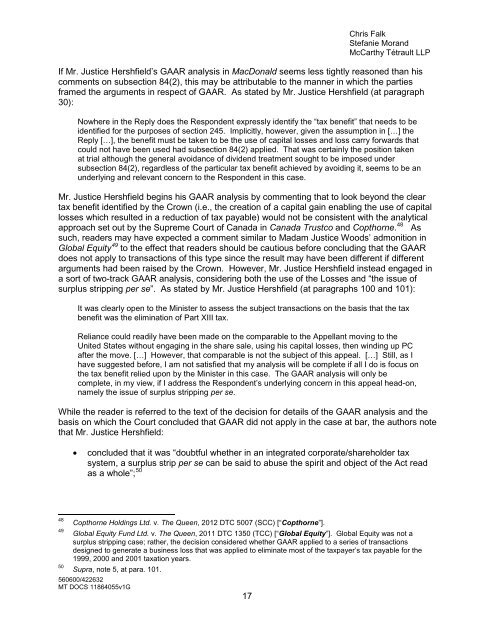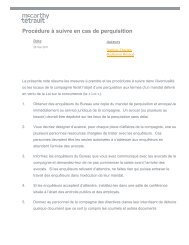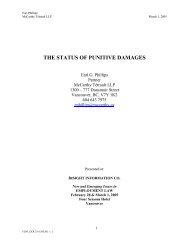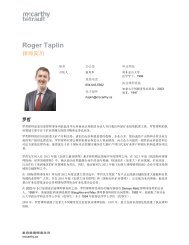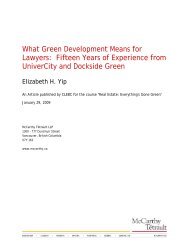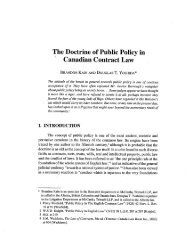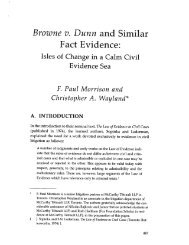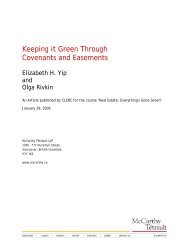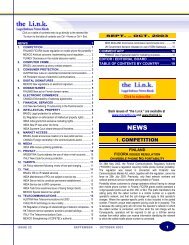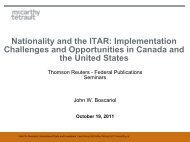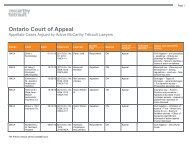Presentation Material - McCarthy Tétrault
Presentation Material - McCarthy Tétrault
Presentation Material - McCarthy Tétrault
You also want an ePaper? Increase the reach of your titles
YUMPU automatically turns print PDFs into web optimized ePapers that Google loves.
Chris Falk<br />
Stefanie Morand<br />
<strong>McCarthy</strong> Tétrault LLP<br />
If Mr. Justice Hershfield’s GAAR analysis in MacDonald seems less tightly reasoned than his<br />
comments on subsection 84(2), this may be attributable to the manner in which the parties<br />
framed the arguments in respect of GAAR. As stated by Mr. Justice Hershfield (at paragraph<br />
30):<br />
Nowhere in the Reply does the Respondent expressly identify the “tax benefit” that needs to be<br />
identified for the purposes of section 245. Implicitly, however, given the assumption in […] the<br />
Reply […], the benefit must be taken to be the use of capital losses and loss carry forwards that<br />
could not have been used had subsection 84(2) applied. That was certainly the position taken<br />
at trial although the general avoidance of dividend treatment sought to be imposed under<br />
subsection 84(2), regardless of the particular tax benefit achieved by avoiding it, seems to be an<br />
underlying and relevant concern to the Respondent in this case.<br />
Mr. Justice Hershfield begins his GAAR analysis by commenting that to look beyond the clear<br />
tax benefit identified by the Crown (i.e., the creation of a capital gain enabling the use of capital<br />
losses which resulted in a reduction of tax payable) would not be consistent with the analytical<br />
approach set out by the Supreme Court of Canada in Canada Trustco and Copthorne. 48 As<br />
such, readers may have expected a comment similar to Madam Justice Woods’ admonition in<br />
Global Equity 49 to the effect that readers should be cautious before concluding that the GAAR<br />
does not apply to transactions of this type since the result may have been different if different<br />
arguments had been raised by the Crown. However, Mr. Justice Hershfield instead engaged in<br />
a sort of two-track GAAR analysis, considering both the use of the Losses and “the issue of<br />
surplus stripping per se”. As stated by Mr. Justice Hershfield (at paragraphs 100 and 101):<br />
It was clearly open to the Minister to assess the subject transactions on the basis that the tax<br />
benefit was the elimination of Part XIII tax.<br />
Reliance could readily have been made on the comparable to the Appellant moving to the<br />
United States without engaging in the share sale, using his capital losses, then winding up PC<br />
after the move. […] However, that comparable is not the subject of this appeal. […] Still, as I<br />
have suggested before, I am not satisfied that my analysis will be complete if all I do is focus on<br />
the tax benefit relied upon by the Minister in this case. The GAAR analysis will only be<br />
complete, in my view, if I address the Respondent’s underlying concern in this appeal head-on,<br />
namely the issue of surplus stripping per se.<br />
While the reader is referred to the text of the decision for details of the GAAR analysis and the<br />
basis on which the Court concluded that GAAR did not apply in the case at bar, the authors note<br />
that Mr. Justice Hershfield:<br />
• concluded that it was “doubtful whether in an integrated corporate/shareholder tax<br />
system, a surplus strip per se can be said to abuse the spirit and object of the Act read<br />
as a whole”; 50<br />
48<br />
49<br />
50<br />
Copthorne Holdings Ltd. v. The Queen, 2012 DTC 5007 (SCC) [“Copthorne”].<br />
Global Equity Fund Ltd. v. The Queen, 2011 DTC 1350 (TCC) [“Global Equity”]. Global Equity was not a<br />
surplus stripping case; rather, the decision considered whether GAAR applied to a series of transactions<br />
designed to generate a business loss that was applied to eliminate most of the taxpayer’s tax payable for the<br />
1999, 2000 and 2001 taxation years.<br />
Supra, note 5, at para. 101.<br />
560600/422632<br />
MT DOCS 11864055v1G<br />
17


